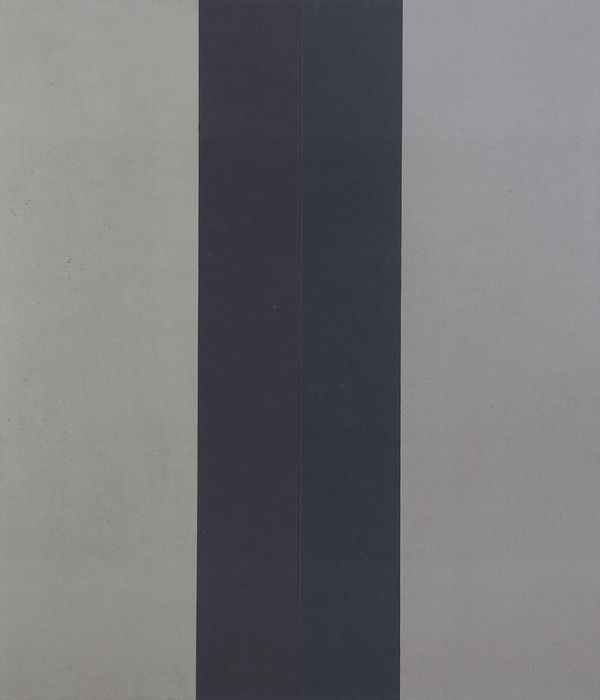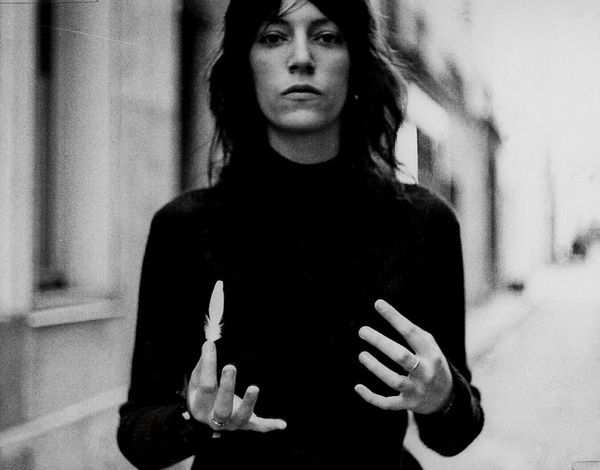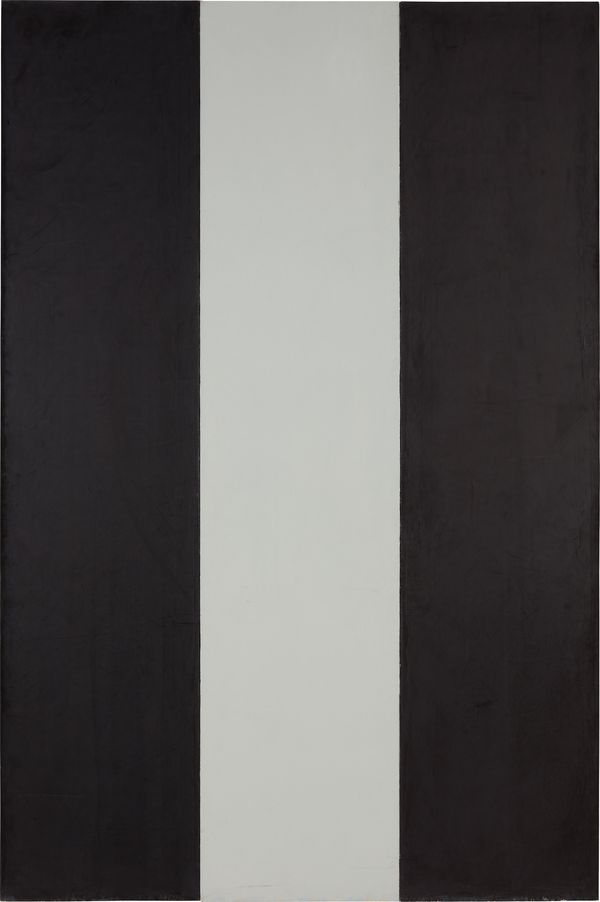Patti Smith. Photo by Linda-Smith-Bianucci.
Upon a Star
A work that embodies light may lead us to
examine the source of our own. As we regard
the night, we are bathed; shone upon. For
piercing the black expanse is the dim and
brilliant din—the stark humor of hope.
A work that is pure code is as obvious and
enigmatic as the impulse whence it came . . .
a stance . . . a bright hitch. Connections are
internalized and may have little to do with a
name or a face. Perhaps indecipherable, yet
one may trace, and be, even momentarily,
carried away.
Into a singular yellow plane. A measured
frame. A series of breathless stills taped to
a blank wall. Falconetti. A vase. A vat of
pigment, kohl, pearl on a polished floor.
The source of our being smiles. The work of
man endures. Even as a turn of the head, in a
certain light, fades into dawn.
— Patti Smith
Upon a Star © Patti Smith
Brice Marden Star (for Patti Smith), 1972-74
Brice Marden’s Star (for Patti Smith), 1972-74, is an elegant and luminous portrait of the artist's close friend and rock star Patti Smith. The painting stands as one of the artist's celebrated abstract "portraits," many of which are held in important institutions' collections including For Carl Andre, 1966 in the Collection of Crystal Bridges Museum of American Art and The Dylan Painting, 1966-86 in the Collection of the San Francisco Museum of Modern Art.
Rendered in minimalist, subdued tones, Star (for Patti Smith) honors the musician and writer whose musical and poetic output drew on the influences of The Velvet Underground and The Doors, along with French Symbolist and Beat strains of introspective and sensual poetry. Marden's succinct rendering of the artist in his own minimalist language "evokes an exciting and intensely creative moment in New York's cultural history," explains art historian Eileen Costello, describing Star (for Patti Smith) as one of Marden's most celebrated portraits. "In the '70s, the city might have been dirty, dangerous and destitute, but downtown had a passionately experimental and vital art scene. When Marden met Smith, she was a waif poet who used to come to his studio to use his typewriter—an Olivetti—because she thought it improved the quality of the rock criticism she was writing for Creem and Rolling Stone."
Seeking to distill Smith's own stark and direct writing style, which would come to define her as the reigning "punk poet laureate" of the downtown art scene, Marden conceived a composition of three vertical stripes. Each separate panel precisely measures Smith's height and shoulder-width, directly and intimately connecting it with the artist's abstract portrait of his wife from 1967. Indeed Star (For Patti Smith) is a natural extension of Marden's Back series, seven single panels executed between 1967-68, that the artist exhibited at Bykert Gallery in January 1968, which found their precedent in Helen. Helen, 1967, named afer the artist's soon-to-be wife, was conceived as two single panels, each Helen's height of 69 inches and shoulderwidth of 17½ inches, exhibited with a slight space between. For Back, Marden retained the height used in Helen but expanded the width of each panel to 45 inches in order to refute any figurative associations. It is the leftover panels set aside for Back that Marden returned to four years later to create Star. Just as in Helen, in Star (for Patti Smith) the physical proportions of the individual are mapped like a grid onto the abstracted portrait, at once retaining and vacating the human presence from the elemental, geometric components of the painting.
My idea for Star was to make a portrait, not a picture of a person. I hoped to embody a spirit.
— Brice Marden
The lustrously soft, yet dynamic surface of the work was created through successive layers of oil paint, melted beeswax and turpentine. Marden first utilized beeswax in his practice in 1966 as a means to eliminate visual interference from the glossy surfaces characteristic of oil paint or varnish. This encaustic medium, once manipulated by the deft touches of Marden's palette knife, yielded a sculptural nuance to the surface of the work. Indeed, the addition of beeswax created a seductively smooth and deceptively matte surface which engendered his paintings with a quiet resonance or physical objecthood that extends the work beyond the confines of its painted surface. This creates a surface tension that encourages the eye to actively traverse the expanse of work, probing the paradoxical depth and fatness that Marden's composition presents. The beeswax acts as a coating sealant, joining the three individual panels into a singular composition.

Brice Marden, Lethykos (for Tonto), 1976. Oil and beeswax on canvas, four panels, overall 84 x 72 in. (213.4 x 182.9 cm), Collection of The Museum of Modern Art, New York © 2016 Brice Marden / Artists Rights Society (ARS), New York.
Executed over a two-year period, Marden first exhibited his portrait of Smith at his solo show at Bykert Gallery, New York in February 1972. The work was exhibited with the third panel in what the artist described as "buttery yellow." Marden subsequently re-visited this composition and reimagined the portrait as two matte midnight black bands which frame the luminous gray "figure" of Smith. This black, which is a color Marden used throughout his practice for its ability to take on a host of associations, only furthers his abstract aims.
As Marden explains in his January 1973 statement and proposal for Star (for Patti Smith) at the time, "Now I plan to work two blacks, warm and cool, against a strong value change to the white-grey flesh, but to keep the flesh strong as color to make the whole strong color. I will think about Zurbaran monk paintings as I work on it, but not in terms of a superfcial color resemblance. I want the plane to have that fanatic Zurbaran intensity."
His ultimate composition perfectly distills the cool reticence and the convention-breaking energy of Smith's personality and artistry. The adherence to a minimal language of form veils, according to the artist, a deep subjective response to Smith's star quality and her immediate human presence. "My idea for Star was to make a portrait, not a picture of a person. I hoped to embody a spirit."

